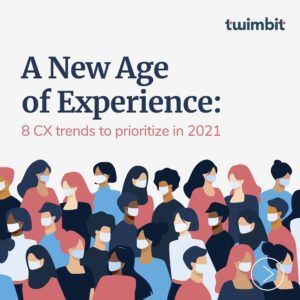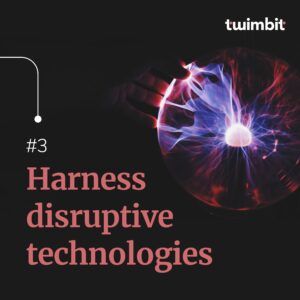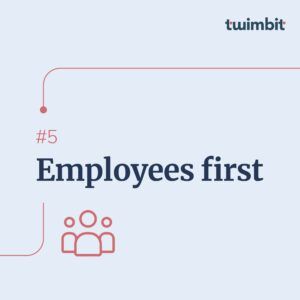Digital transformation that would normally take around five years has taken only a year in 2020. Businesses had to quickly respond to the rapidly changing and uncertain environment. The effects of these innovations in the customer experience space within companies will still linger in 2021. We foresee that the new year will be a phase of transition, one in which business leaders will try to understand the long-term implications of their renewed strategy.
#1 Leadership alignment for success
When the COVID-19 pandemic struck, a focus on customer experience became imperative for businesses to sustain competitive advantage. Though many businesses did have their customer experience strategy in place, shifting customer consumption behavior revealed disjointed experiences.
While different functions in an organization – marketing, sales, digital – work towards a single goal of providing great customer experience, interdepartmental silos are still prevalent. The success of cross-functional teams depends on the synergy and understanding of trade-offs made in decision-making across departments. Additionally, the establishment of a customer experience advisory board is essential to ensure that business strategy is aligned to the evolving needs of the industry.
In 2021, we foresee organizations integrate disparate processes, technologies and teams to deliver a seamless customer experience. The ability to empower and enable these teams to execute a holistic customer experience strategy will differentiate the winners from the losers.
#2 A self-service led approach
As avid online users, we expect the Internet to answer any and all questions we have instantaneously. Customers expect businesses to operate in the same way – fast, intuitive and relevant information literally at their fingertips.
Introducing chatbots, in particular, is a popular method to ensure a self-service led approach. However, the pandemic has put the efficacy of chatbots to the test. The variability in queries during the pandemic has exposed how dynamic responses suffer during uncertain times.
Various channels such as a traditional phone call, live chat, voice assistants are now available when a customer seeks support. Self-service is about providing digital accessibility ensuring basic information and customer support are available. A self-service approach optimizes digital journeys designed with thought and fluidity to resolve customer issues on the first attempt.
#3 Harness disruptive technologies
Cloud saves the day
39% of companies in the Asia Pacific intend to adopt cloud contact centers within 24 months, while 44% have deployed cloud solutions. COVID-19 has undoubtedly accelerated the adoption of cloud solutions in organizations. Major challenges of adoption such as security and deployment complexity were quickly overcome. Businesses are reinforced by the importance of scalability, flexibility and resilience in times of crisis. The increasing availability of multi-cloud deployment makes cloud adoption more viable to companies.
Tapping the full potential of artificial intelligence (AI)
In 2021, we will see a change in the way organizations leverage AI. Organizations will move from reactive to proactive engagement customer support, while fully leveraging the power of AI by providing employees assistance with “in-moment” coaching or real-time suggestions in assisting customers. The pandemic will also cause a surge in workforce management applications as remote working models and hybrid working practices become commonplace.
#4 Enable a secure yet frictionless experience
The reliance on online services, increased penetration of smartphones and the Internet around the globe means a higher volume of personal and financial data transferred over the Internet. In 2020, both companies and individuals were vulnerable to cyberattacks, frauds and phishing.
Customers are vocalizing concerns over their personal information and the increased risk of a data breach. More importantly, companies are hosting vital infrastructure online. Security is a top concern among all users, and the concept of Zero Trust is now widespread.
We predict that in 2021, while security measures will be more robust, companies will redesign customer journeys to be frictionless and ensure security. AI in particular has a big role to play in enabling a secure and frictionless experience.
#5 Employees first
Good customer experience starts with the employees – evidently shown in 2020. The pandemic has disrupted the lives of employees and fundamentally changed how we operate. Particularly, the emphasis has shifted from employee productivity to a holistic employee experience. This requires business leaders to reexamine the organizations’ employee experience values, strategies and practices.
Unexpected conditions of the pandemic further exacerbate common challenges such as burnout and work-life balance. Furthermore, technology is now permanently stamped into employees’ lives with tools needed to collaborate effectively and applications to assist workers.
Practiced empathy will take a front seat in 2021, where flexible working hours, financial, health and well-being support takes precedence. Businesses can adopt the Twimbit employee experience framework of practiced empathy, culture, technology, employee as a customer, and rewards and benefits.
#6 A hybrid working model
The future of work has always been moving in the direction of a more flexible working model. The transition was sped up as a response to COVID-19. Companies around the globe had to engage a remote workforce – halving the density of its offices – as a business continuity plan.
Notably, the perception of employees shirking work without supervision was quickly shattered when employees adapted to this new remote model. Remote working promises a global pool of talent, cost savings and improves employee retention.
A hybrid working model is likely to continue even post-pandemic as the mass experiment has shown productivity levels have maintained and even increased. This shows organizational resilience in this non-traditional working model.
Business leaders must ensure employees are equipped with the right tools and resources – training, technology, support – to sustain and engage a high performing workforce.
#7 ‘Phy-gital’ experiences
Companies are moving beyond binary ideas of physical and digital environments. While customer dependence online has risen, physical stores still play an important role in the overall brand experience of a company.
Businesses with physical stores have begun integrating digital components within their physical stores such as contactless purchasing, real-time store inventory availability and offline pickups.
The trend of ‘phy-gital’ experiences will see companies moving to practical options for customers – making available the option of completing the customer cycle digitally or physically. In 2021, we foresee more connected experiences between the online presence and physical storefronts of companies.
#8 Transition to a consumption-based business model
A consumption-based business model commonly described as ‘pay for what you use’ or ‘pay-as-you-go’ (PAYG) has grown traction for the past decade. In times of uncertainty and constant changes, both businesses and individuals favor services that offer choice, customization and flexibility.
As a customer, we want to customize products according to our needs – without the fear of being locked into a long-term commitment and an unsuitable bundle offering. We want to take control and match our consumption to our spending.
The IT industry – Internet, content and telecommunications providers – are pioneering the PAYG model. This model is used for cloud solutions, enabling companies to be agile, harness the latest technologies on-demand and optimize their usage of resources. This will become the primary model of technology consumption for companies. We foresee this business model making headway across various industries in 2021, where customers can personalize services to match their consumption.












